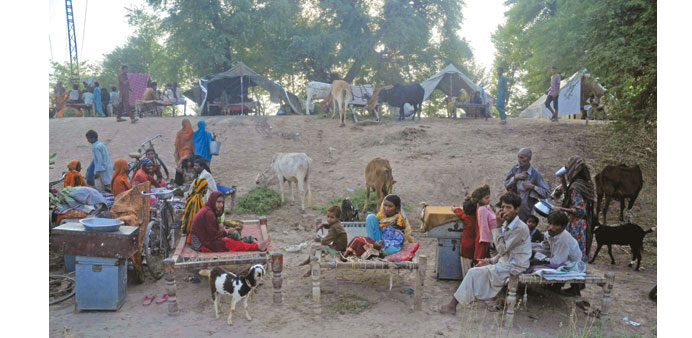DPA
Islamabad
|
|
Authorities were struggling yesterday to rescue thousands of people stranded by floods in more than 100 villages in central Pakistan, officials said.
Several artificial breaches were created along the protective embankments of Chenab river to divert floodwater away from the historic city of Multan, civilian administrator Zahid Saleem said.
He said the threat to the city was almost over, but the diversion of water has affected 126 small villages and hamlets.
Thousands of relief workers, policemen and soldiers were working to evacuate areas and deliver relief supplies, state-run Pakistan Television reported.
The flooding began September 3 due to heavy monsoon rains.
About 280 people have been killed in the eastern province of Punjab province, Pakistan-administered Kashmir and the semi-autonomous Gilgit-Baltistan regions in the north, National Disaster Management Authority official Ahmed Kamal said.
More than 2mn people have been displaced.
The disaster agency said the flooding would continue for at least another week before the excessive water could drain out through the southern province of Sindh.
With floodwaters moving downstream to Pakistan’s south, the provinces of Sindh and Punjab, where already large swathes have come under water, are facing the threat of fuel shortage as oil marketing companies (OMCs) have failed to build enough storage facilities.
“The fuel supply situation is likely to be the same as experienced in the 2010 floods and Punjab and Sindh could see supplies dwindle if roads connecting the two provinces are swept away by the floods,” an official said.
“We have directed the oil marketing companies to ensure the availability of oil supplies to consumers in this difficult situation,” said Azam Khan, director general (oil) at ministry of petroleum and natural resources.
The DG (oil) is a regulator of the OMCs and must ensure that adequate storage facilities are put in place by the marketing companies to keep oil stocks in order to meet immediate needs in times of emergency.
Under the marketing licence, OMCs are required to establish storages to keep oil stocks for 20 days. During the floods of 2010, Punjab and Balochistan struggled to deal with acute fuel scarcity due to lack of oil reserves and consumers were forced to pay as high as Rs200 for a litre of petrol.
Following the 2010 deluge, the National Assembly Standing Committee on Petroleum and Natural Resources directed then DG to make efforts and press the OMCs to build storages for keeping fuel stocks for 20 days as per the licence requirements.
“Since 2010, no major storages have been built, which is a violation of the OMCs’ licensing conditions. In that year, the country had the capacity to store one million tons of petroleum products,” the official said.
The DG has failed to serve notices on the OMCs for not complying with the licensing requirements about keeping reserves.
According to officials, Pakistan State Oil has 74% of total storage facilities in the country. It had contributed a lot to ease the bottlenecks and ensure a smooth supply of oil in 2010 and the responsibility would again fall on the company in case of any disruption.



